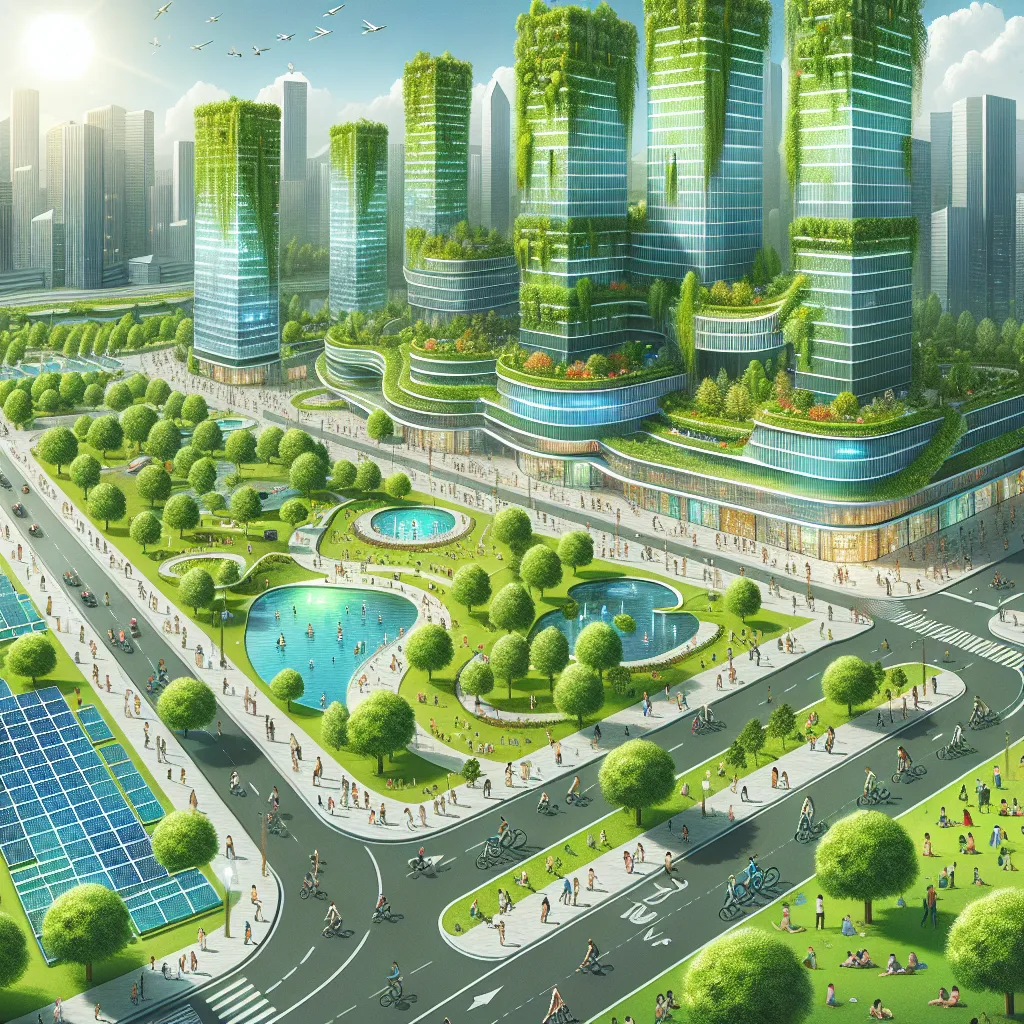Welcome to this IELTS Reading practice test focused on “The role of urban planning in addressing climate change.” This topic is increasingly relevant in today’s world as cities grapple with the challenges posed by climate change. This practice test will not only help you prepare for the IELTS Reading section but also provide valuable insights into how urban planning can contribute to climate change mitigation and adaptation.
 Urban planning for climate change
Urban planning for climate change
Let’s dive into the test, which consists of three passages of increasing difficulty, followed by a variety of question types typical of the IELTS Reading exam.
Passage 1 – Easy Text
Urban Planning and Climate Change: A Crucial Connection
Climate change is one of the most pressing issues of our time, and cities play a significant role in both contributing to and potentially mitigating its effects. Urban areas are responsible for a large portion of global greenhouse gas emissions, yet they also have the potential to lead the way in climate change adaptation and mitigation strategies. This is where urban planning comes into play.
Urban planning is the process of designing and organizing urban spaces and systems. It involves decisions about land use, transportation, housing, and infrastructure. In the context of climate change, urban planners are increasingly focusing on creating sustainable and resilient cities that can withstand the impacts of a changing climate while reducing their carbon footprint.
One key aspect of climate-conscious urban planning is the promotion of compact city designs. By encouraging higher density development and mixed-use neighborhoods, planners can reduce the need for car travel and promote walking, cycling, and public transportation. This not only reduces emissions but also improves air quality and public health.
Another important strategy is the incorporation of green infrastructure. This includes creating and maintaining urban parks, green roofs, and street trees. These green spaces not only absorb carbon dioxide but also help to reduce the urban heat island effect, where cities are significantly warmer than surrounding rural areas due to the abundance of heat-absorbing surfaces like concrete and asphalt.
Urban planners are also focusing on energy-efficient buildings and promoting the use of renewable energy sources. This might involve updating building codes to require better insulation and more efficient heating and cooling systems, or incentivizing the installation of solar panels on rooftops.
Water management is another crucial area where urban planning can make a difference. As climate change leads to more frequent and severe flooding in some areas and water scarcity in others, planners are implementing strategies such as permeable pavements, rain gardens, and water recycling systems to better manage urban water resources.
Finally, urban planners are increasingly considering climate resilience in their designs. This means creating urban environments that can withstand and recover from extreme weather events, which are becoming more common due to climate change. This might involve designing flood-resistant infrastructure, creating evacuation routes, or ensuring that critical services can continue to function during disasters.
In conclusion, urban planning has a crucial role to play in addressing climate change. By reimagining our cities as sustainable, efficient, and resilient spaces, urban planners can help to reduce emissions, adapt to changing conditions, and create healthier, more livable urban environments for all.
Questions 1-7
Do the following statements agree with the information given in the passage?
Write
TRUE if the statement agrees with the information
FALSE if the statement contradicts the information
NOT GIVEN if there is no information on this
- Urban areas are responsible for a small portion of global greenhouse gas emissions.
- Urban planning involves decisions about land use, transportation, housing, and infrastructure.
- Compact city designs can help reduce the need for car travel.
- Green infrastructure only includes urban parks and street trees.
- Energy-efficient buildings are a key focus of climate-conscious urban planning.
- Water management strategies are not important in urban planning for climate change.
- Climate resilience in urban design involves creating environments that can withstand extreme weather events.
Questions 8-13
Complete the sentences below.
Choose NO MORE THAN TWO WORDS from the passage for each answer.
- Urban planners are increasingly focusing on creating __ and __ cities that can withstand the impacts of climate change.
- __ __ designs encourage higher density development and mixed-use neighborhoods.
- Green spaces help to reduce the __ __ __, where cities are significantly warmer than surrounding rural areas.
- Updating building codes may require better __ and more efficient heating and cooling systems.
- Permeable pavements and rain gardens are examples of __ __ strategies.
- Urban planners are considering __ __ in their designs to create environments that can withstand extreme weather events.
Passage 2 – Medium Text
Innovative Urban Planning Strategies for Climate Change Mitigation
As the global community grapples with the escalating climate crisis, cities are emerging as crucial battlegrounds in the fight against climate change. Urban areas, home to more than half of the world’s population and responsible for over 70% of global CO2 emissions, are uniquely positioned to spearhead innovative solutions. Urban planners, architects, and policymakers are now tasked with reimagining cityscapes to not only reduce carbon footprints but also enhance resilience to climate-related challenges.
One groundbreaking approach gaining traction is the concept of the “15-minute city.” This urban planning model, pioneered in Paris, aims to design neighborhoods where all essential services – work, shopping, healthcare, education, and leisure – are accessible within a 15-minute walk or bike ride. By reducing the need for long commutes and car dependency, this model significantly cuts transportation-related emissions while improving quality of life for residents.
Another innovative strategy is the integration of nature-based solutions into urban design. Cities like Singapore have become global leaders in this approach, implementing extensive green building policies that mandate the inclusion of vertical gardens and sky parks in new developments. These green spaces not only sequester carbon but also mitigate the urban heat island effect, reduce energy consumption for cooling, and enhance biodiversity within city limits.
The concept of circular economy is also being applied to urban planning, with cities like Amsterdam leading the way. This approach focuses on minimizing waste and maximizing resource efficiency. In practice, this might involve designing buildings with modular, reusable components, implementing city-wide composting and recycling programs, or creating industrial symbiosis parks where one company’s waste becomes another’s raw material.
Smart city technologies are playing an increasingly important role in climate change mitigation efforts. Cities like Barcelona are leveraging Internet of Things (IoT) devices and big data analytics to optimize energy use, water management, and traffic flow. Smart grids enable more efficient integration of renewable energy sources, while intelligent traffic systems reduce congestion and associated emissions.
Urban food systems are another area of focus, with cities like Detroit pioneering urban agriculture initiatives. Rooftop gardens, vertical farms, and community allotments not only reduce food miles and associated transportation emissions but also enhance food security and community resilience.
Climate-responsive architecture is evolving to address both mitigation and adaptation needs. Buildings are being designed to passively regulate temperature, reducing the need for energy-intensive heating and cooling. In flood-prone areas, architects are creating amphibious structures that can rise with floodwaters, while in drought-prone regions, buildings are being equipped with rainwater harvesting systems.
Transportation infrastructure is being reimagined with a focus on low-carbon mobility. Cities like Copenhagen have invested heavily in cycling infrastructure, making it the preferred mode of transport for a majority of residents. Others, like Curitiba in Brazil, have pioneered Bus Rapid Transit systems that provide efficient, low-cost public transportation alternatives to private cars.
Importantly, urban planners are increasingly recognizing the need for community engagement and social equity in climate action plans. Cities like Portland, Oregon, have developed climate action plans with a strong focus on environmental justice, ensuring that the benefits of green initiatives are equitably distributed and that vulnerable communities are prioritized in resilience efforts.
The challenges posed by climate change are immense, but so too are the opportunities for innovation in urban planning. As cities continue to grow and evolve, the strategies they employ to address climate change will play a crucial role in shaping the future of our planet. By embracing these innovative approaches, cities can not only reduce their environmental impact but also become more livable, equitable, and resilient in the face of climate change.
Questions 14-19
Choose the correct letter, A, B, C, or D.
-
According to the passage, cities are responsible for:
A) Less than 50% of global CO2 emissions
B) Exactly 50% of global CO2 emissions
C) More than 70% of global CO2 emissions
D) 100% of global CO2 emissions -
The “15-minute city” concept aims to:
A) Increase car dependency
B) Lengthen commute times
C) Reduce transportation-related emissions
D) Separate residential areas from commercial zones -
Singapore is mentioned as an example of a city that:
A) Has banned all new building developments
B) Has implemented extensive green building policies
C) Has removed all parks within the city limits
D) Has increased energy consumption for cooling -
The circular economy approach in urban planning focuses on:
A) Increasing waste production
B) Maximizing resource inefficiency
C) Minimizing waste and maximizing resource efficiency
D) Designing buildings with non-reusable components -
Smart city technologies are being used to:
A) Increase energy consumption
B) Worsen traffic congestion
C) Optimize energy use and traffic flow
D) Reduce the use of renewable energy sources -
Climate-responsive architecture aims to:
A) Increase the need for energy-intensive heating and cooling
B) Create buildings that cannot withstand extreme weather
C) Design structures that can adapt to different climate conditions
D) Eliminate the use of rainwater harvesting systems
Questions 20-26
Complete the summary below.
Choose NO MORE THAN TWO WORDS from the passage for each answer.
Urban planning strategies for climate change mitigation are becoming increasingly innovative. The concept of the “15-minute city” aims to reduce (20) __ and improve quality of life. Cities like Singapore are implementing (21) __ __ to increase green spaces in urban areas. The (22) __ __ approach focuses on minimizing waste and maximizing resource efficiency. (23) __ __ technologies are being used to optimize various city functions. Urban (24) __ initiatives are helping to reduce food miles and enhance food security. In transportation, cities are focusing on (25) __ mobility options. Finally, urban planners are recognizing the importance of (26) __ __ in ensuring that climate action plans are equitable and inclusive.
Passage 3 – Hard Text
The Nexus of Urban Planning and Climate Change: Challenges and Opportunities
The intricate relationship between urban planning and climate change presents a complex tapestry of challenges and opportunities that are reshaping the way we conceptualize and design our cities. As urbanization continues at an unprecedented pace, with projections indicating that 68% of the world’s population will reside in urban areas by 2050, the role of cities in both exacerbating and potentially mitigating climate change becomes increasingly pivotal.
Urban areas are responsible for approximately 75% of global CO2 emissions, primarily due to transportation, buildings, and industry. This statistic underscores the urgent need for a paradigm shift in urban planning practices. However, the density and concentration of resources in cities also present unique opportunities for implementing large-scale, impactful solutions to address climate change.
One of the most significant challenges in urban planning for climate change mitigation is the inertia of existing infrastructure. Many cities, particularly in developed countries, have deeply entrenched systems and structures that were designed and built in an era when climate change was not a consideration. Retrofitting or replacing this infrastructure is often costly and logistically complex, requiring long-term planning and substantial investment.
Moreover, urban planners must grapple with the competing demands of rapid urbanization, economic development, and environmental sustainability. In many rapidly growing cities in the Global South, the immediate needs for housing, transportation, and basic services often take precedence over long-term climate considerations. Balancing these short-term necessities with long-term climate resilience is a delicate and often contentious process.
The uncertainty inherent in climate projections poses another significant challenge for urban planners. While there is scientific consensus on the overall trajectory of climate change, the specific local impacts can be difficult to predict with precision. This uncertainty complicates the process of designing infrastructure and systems that need to be resilient over many decades.
Despite these challenges, innovative urban planning approaches are emerging that hold promise for addressing climate change. The concept of ‘sponge cities’, pioneered in China, is one such approach. This model involves designing urban areas to absorb, clean, and use rainfall in an ecologically friendly way, reducing flood risks and conserving water resources. Cities like Wuhan have implemented this approach, incorporating permeable pavements, rain gardens, and wetlands into their urban fabric.
Another promising strategy is the development of ‘urban metabolism’ frameworks. This approach views cities as living organisms, analyzing the flow of resources (energy, water, materials) through urban systems. By understanding these flows, planners can identify inefficiencies and implement strategies to create more circular, sustainable urban economies. Stockholm’s Royal Seaport district is an exemplar of this approach, aiming to be fossil fuel-free by 2030 through careful management of resource flows.
The integration of advanced data analytics and artificial intelligence in urban planning is opening new frontiers in climate change mitigation. ‘Digital twin’ technologies, which create virtual replicas of cities, allow planners to model and test the impacts of various interventions before implementation. Singapore’s Virtual Singapore project is a prime example, enabling planners to simulate the effects of urban heat island mitigation strategies and optimize energy use across the city.
Biophilic design, which seeks to integrate nature into urban environments, is gaining traction as a means of both mitigating and adapting to climate change. Cities like Medellin, Colombia, have transformed urban heat islands into cool, green corridors, not only reducing temperatures but also improving air quality and biodiversity.
The concept of ‘tactical urbanism’ is emerging as a way to test and implement climate-friendly urban interventions quickly and cost-effectively. This approach involves small-scale, often temporary changes to the built environment, such as pop-up bike lanes or parklets, which can be scaled up if successful. During the COVID-19 pandemic, many cities used tactical urbanism to rapidly reclaim street space for pedestrians and cyclists, demonstrating the potential of this approach for climate-friendly urban transformations.
Perhaps most critically, there is growing recognition of the need for interdisciplinary collaboration in urban planning for climate change. The complexity of the challenge requires input from climate scientists, ecologists, engineers, social scientists, and community stakeholders, among others. Cities like Rotterdam have embraced this approach, creating multi-stakeholder platforms to develop and implement their climate adaptation strategies.
In conclusion, while the challenges of addressing climate change through urban planning are formidable, they are not insurmountable. The innovative approaches emerging around the world demonstrate the potential for cities to become crucibles of climate solutions. As we move forward, it will be crucial to share knowledge, scale up successful interventions, and foster the political will necessary to transform our cities into sustainable, resilient, and livable spaces in the face of climate change.
Questions 27-31
Choose the correct letter, A, B, C, or D.
-
By 2050, what percentage of the world’s population is projected to live in urban areas?
A) 50%
B) 68%
C) 75%
D) 100% -
What is described as one of the most significant challenges in urban planning for climate change mitigation?
A) Lack of funding
B) Political opposition
C) Inertia of existing infrastructure
D) Shortage of urban planners -
The concept of ‘sponge cities’ involves:
A) Building more water parks
B) Increasing water consumption
C) Designing cities to absorb and use rainfall efficiently
D) Creating artificial lakes in urban areas -
What does the ‘urban metabolism’ framework view cities as?
A) Living organisms
B) Mechanical systems
C) Economic hubs
D) Political entities -
Which city is mentioned as an example of using ‘digital twin’ technology?
A) Stockholm
B) Wuhan
C) Medellin
D) Singapore
Questions 32-36
Complete the sentences below.
Choose NO MORE THAN THREE WORDS from the passage for each answer.
- Urban areas are responsible for approximately __ of global CO2 emissions.
- The __ in climate projections makes it difficult for urban planners to design long-term resilient infrastructure.
- The Royal Seaport district in Stockholm aims to be __ by 2030.
- __ seeks to integrate nature into urban environments as a means of mitigating and adapting to climate change.
- __ involves small-scale, often temporary changes to the built environment to test climate-friendly urban interventions.
Questions 37-40
Do the following statements agree with the claims of the writer in the passage?
Write
YES if the statement agrees with the claims of the writer
NO if the statement contradicts the claims of the writer
NOT GIVEN if it is impossible to say what the writer thinks about this
- The challenges of addressing climate change through urban planning are impossible to overcome.
- Interdisciplinary collaboration is crucial in urban planning for climate change.
- All cities globally have embraced advanced data analytics


